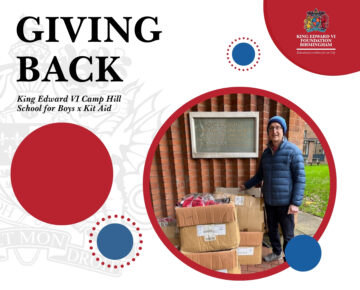Aside from collecting and cataloguing documents, part of an Archivists job is to conserve their material for permanent preservation. This involves looking out for anything that has already damaged your records or anything that might potentially damage them in the future. A small knowledge of how chemicals in paper, metal and plastic degrade can go a long way in the battle against the ravages of time.
When a new document or artefact comes into the archive, it is firstly kept in quarantine for 2 weeks which allows time for anything hazardous to surface. I once had a whole sack of spider eggs hatch in a book during a quarantine period and enjoyed a merry afternoon trying to remove them (humanely, but quickly) from the premises!
Once this time period has elapsed, the first step in the process to examine the piece and start by giving it a good clean – this is a KES straw boater that was donated to us last year. Despite being kept extremely well, it was a little dusty and in need of a gentle wash…


Before and after – this was done with just warm water and gentle persuasion
Once ready, material can finally be packed in acid-free boxes and stored in our temperature and humidity regulated store.
Other things we need to look out for are…
Metal
One of the most common problems faced by archives is rust – it is everywhere. Paper clips, staples, ring binders, fasteners. The rust eats through the paper and damages anything it comes into sustained contact with. You can see some examples of the damage this has done to documents over the years.


Sellotape
Another material that leaves permanent damage is sellotape. Over the years, it is clear that sellotape was the weapon of choice for fixing torn pages and a good alternative to paperclips for attaching things. Unfortunately, these people who tried to innocently mend items have only made them worse. Over time sellotape begins to lose its adhesive properties and starts to go brittle. It then falls away from the paper losing the information attached and leaving tears vulnerable. Not only does it not work, it also leaves behind a pale yellow mark. The moral story? Avoid sellotape at all costs.
Water Damage
Water damage is extremely harmful and can ruin documents instantly; this is an example of water damage on a ledger. This is a financial ledger from 1859 which has come into contact with water at some point in its life. As you can see it has stained the cover and the paper within and in some cases destroyed the ink handwriting inside. Water is usually just the start of a problem – if left untreated the damp areas can then begin to grow…
Mould
Mould loves to thrive in damp, warm conditions. It comes in an array of different colours and creates some sometimes quite pretty patterns, but unfortunately, if left it will ultimately eat through paper and causes it to totally disintegrate. It is also highly contagious and can spread easily. Normally the only solution is kill off the mould by freezing the effected document (yes, I have put books in my freezer in the past!) Once the mould has been killed, the dead spores are brushed off but unfortunately the staining remains and the damage is done.

Red Rot
One of the more uncommon problems but one of the most horrific is red rot. Red rot appears when leather which has been vegetable tanned begins to degrade due to high temperatures or high humidity. Red rot isn’t always immediately apparent (especially if the leather is bright red) so you may only realise when you pick up an object. The red powder produced by the degradation breaks away from the item and stains boxes, clothes and skin.
Pests
Archives are delicious to some creatures – in particular silverfish and moths. These creatures will happily much into paper or clothing causing irreparable damage. To prevent this we keep archival material in boxes which makes them harder to reach. We also regularly hoover the archive, as dust can attract them, and put out sticky traps which capture any rouge insects before they get a chance to feast.

The good news is that while some of these aren’t curable, the damage they cause can be stopped from getting worse. While the document is sometimes damaged, it isn’t gone and can still provide many interesting details about the history of the Foundation.









